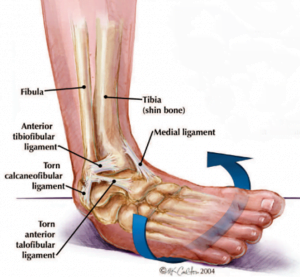Why do I keep spraining my ankle?
 Our osteopaths in Bath treat a lot of people who have either recently sprained their ankle or keep spraining it over a period of months or years. Why do some people seem to keep spraining their ankles? What can be done to stop it from happening again?
Our osteopaths in Bath treat a lot of people who have either recently sprained their ankle or keep spraining it over a period of months or years. Why do some people seem to keep spraining their ankles? What can be done to stop it from happening again?
The biggest risk factor for people re-spraining their ankle is that the original sprain was not rehabilitated sufficiently to deal with the activity they are now doing. Around 40% of people who sprain an ankle will go on to re-sprain it, and 20% will develop a chronic instability that can affect future participation in their activity and the level of potential performance (1).
What is an ankle sprain?
 The ankle is one of the most commonly injured joints in the body, and ankle sprains account for 85% of all ankle injuries. The risk of an ankle sprain is increased if you play high-impact sports, such as football or basketball, or if you take very little exercise making the ankles vulnerable to the demands of activity in general. There are a few types of ankle sprain, around 85% of them are lateral ankle sprains, meaning that the foot has rolled outwards over stretching the ligaments and muscles on the outside of the ankle (2). For a more in-depth look at what happens when you sprain your ankle have a look at our article on ankle sprains.
The ankle is one of the most commonly injured joints in the body, and ankle sprains account for 85% of all ankle injuries. The risk of an ankle sprain is increased if you play high-impact sports, such as football or basketball, or if you take very little exercise making the ankles vulnerable to the demands of activity in general. There are a few types of ankle sprain, around 85% of them are lateral ankle sprains, meaning that the foot has rolled outwards over stretching the ligaments and muscles on the outside of the ankle (2). For a more in-depth look at what happens when you sprain your ankle have a look at our article on ankle sprains.
What happens to an ankle after a sprain?
Depending on the severity of the ankle sprain most people will return to full activity within a few weeks, with or without seeking any treatment for the sprain. This could be the reason many people suffer recurrences of their sprain. Once an ankle is sprained several changes take place to the affected tissues.
- The ligaments on the outside of the ankle are responsible for limiting the ‘rolling over’ of the ankle joint. Many ankle sprains cause an ‘overstretch’ to the ligaments on the outside of the ankle which means that the ankle can more easily sprain again.
- The muscles, ligaments, and other soft tissues around the ankle also contain lots of mechanoreceptors – these are structures that help the body’s nervous system sense what the joint is doing and then influence the body’s coordination through muscular contraction (Hertel). It is known that an ankle sprain has a detrimental effect on these processes meaning that the ankle cannot respond as quickly or efficiently as before making it more likely that it could suffer another sprain.
- The muscles that control the side-to-side movement of the ankle also become weakened increasing the body’s ability to resist another sprain (3).
All these factors may result in chronic ankle instability.
What can I do to stop my ankle from spraining?
The most effective way to guard against a future sprain is to improve the functioning of the tissues that have become affected by the previous sprain. This can be done with a mix of manual therapy and exercise prescription.
The first thing to do is get a thorough assessment of your ankle by an expert, such as an osteopath. The assessment should include
- A thorough case history of any previous sprains and their severity.
- a full examination of the ankle to determine which structures are weak/tight/reduced in capacity, as well as some balance testing.
- An understanding of what activity you wish to be able to perform would inform the level to which the ankle needs to be able to perform (e.g. walking without pain would need less strength to achieve than an aggressive sport such as basketball)
Once the ankle has been assessed then good rehabilitation would include;
- mobilization of the ankle joints to ensure sufficient movement across the ankle (4).
- Strength work to begin to strengthen the weakened muscles around the ankle.
- Balance and proprioception work – this is using exercises that challenge the body’s mechanoreceptors to help improve reaction times in the firing of muscles and feeding back to the brain the position of the ankle (5).
- Sport-specific/return to sport exercises – these are used to prepare the ankle to return to whatever activity that you wish to participate in and often include running and turning rills, or plyometric exercises like leaping and bounding (6).
The length of time that this process would take depends on the severity of the original sprain, the type of activity that you wish to return to, and the variability of the speed of each rehabilitation phase.
Do you want to know what is causing your pain and if we can help? Why not take advantage of our new patient assessment introductory offer to get you started towards a tailor made recovery plan for only £19.
Are you in a lot of pain and want to get better as soon as possible? If so then why not book in for a new patient consultation, with treatment on the day, for £75.
References –
1 – Al-Mohrej OA, Al-Kenani NS. Chronic ankle instability: Current perspectives. Avicenna journal of medicine. 2016 Oct;6(4):103.
2 – Carnes, M, & Vizniak, N. (2011). Conditions Manual. Professional Health Systems, Canada.
3 – Hertel J.Sensorimotor deficits with ankle sprains and chronic ankle instability. Clinics in sports medicine. 2008 Jul 31;27(3):353-70.
4 – Loudon JK, Reiman MP, Sylvain J. The efficacy of manual joint mobilisation/manipulation in the treatment of lateral ankle sprains: a systematic review. Br J Sports Med. 2014 Mar;48(5):365-70.
5 – Kaminski TW, Hertel J, Amendola N, Docherty CL, Dolan MG, Hopkins JT, Nussbaum E, Poppy W, Richie D; National Athletic Trainers’ Association. National Athletic Trainers’ Association position statement: conservative management and prevention of ankle sprains in athletes. J Athl Train 2013; 48: 528-545
6 – Chen ET, McInnis KC,Borg-Stein J. Ankle Sprains: Evaluation, Rehabilitation, and Prevention. Current Sports Medicine Reports 2019 (June);18(6): 217-223.


